Students can access the CBSE Sample Papers for Class 12 Informatics Practices with Solutions and marking scheme Term 2 Set 11 will help students in understanding the difficulty level of the exam.
CBSE Sample Papers for Class 12 Informatics Practices Term 2 Set 11 with Solutions
Maximum Marks : 35
Time : 2 hours
Instructions:
- The question paper is divided into 3 sections – A, B and C.
- Section A, consists of 7 questions (1-7). Each question carries 2 marks.
- Section B, consists of 3 questions (8-10). Each question carries 3 marks.
- Section C, consists of 3 questions (11-13). Each question carries 4 marks.
- Internal choices have been given for question numbers -1, 3, 8 and 12.
Section – A
(Each question carries 2 Marks)
Question 1.
Two doctors are sitting in a room with their laptops connected and they want to share certain medical information among them. What kind of network is formed?
Or
Raunak is uploading the updated web pages of his website into the web server. What is this process termed as?
Answer:
A PAN or Personal Area Network is a network of personal devices connected in a small area.
Or
Web hosting is a process of transferring or uploading the web pages of a website to a public server, so that they are available publicly to clients through out the network.
Question 2.
(i) Ahitagni wanted to know,whether the devices Modem, Router, UPS and Repeater have a role player in a network or not. Help him in identifying the device(s) that do not have any role as a network device.
Answer:
UPS – Uninterrupted Power Supply is a power supply device and is not an essential component for a network.
(ii) Ravi was told by his teacher to identify the improper browser name from the following – Google Chrome, Mozilla Firefox, Internet Explorer, MySQL . Suggest him the one that is not a web browser.
Answer:
MySQL is a database management system. All the others are popular web browsers.
![]()
Question 3.
While facing an interview for the position of Database operator, Suman was asked to explain in short the uses of the following MySQL functions. Help her with the answers,
(i) LENGTH()
(ii) SUBSTR()
Or
Suman was also offered with a choice of explaining the following two functions. Give her a short explanation of the following MySQL functions.
(i) LCASE()
(ii) UCASE()
Answer:
(i) LENGTH() function returns the number of characters in a string.
(ii) SUBSTR( ) function extracts a part of a string from a start position and number of characters specified.
Or
(i) LCASE() function converts a string to lowercase.
(ii) UCASE() function converts a string to uppercase.
Question 4.
Sunita’s boss asked her two reasons of why they should implement the star topology instead of ring topology in their office. Help her in the explanation.
Answer:
(i) Node failure does not cause network failure.
(ii) Fault detection and isolation is easy.
Question 5.
The SUBSTR() function of MySQL is bothering Ritesh. Help him with two example commands to understand the working of the function.
(i) SELECT SUBSTR(‘‘AISSCE2022”,4,3);
Answer:

The SUBSTR() function extracts certain number of characters from a starting position and number of characters specified. Here the function extracts 3 characters from position 4 of the string.
(ii) SELECT SUBSTR(“AISSE2021-22”,- 6,3);
Answer:

The SUBSTR() function extracts certain number of characters from a starting position and number of characters specified. Here the function extracts 3 characters from position -6( 6 characters backward from the right) of the string.
![]()
Question 6.
You are assigned the job to explain the utility of GROUP BY clause to your fellow members, of how it can be used to produce useful reports. Explain them with proper examples.
Answer:
The SQL GROUP BY clause can be used to group records of a table on the basis of common values in a column. Such groups can be formed to produce aggregate values such as total, average, count, maximum, minimum etc. The aggregate functions play an important role along with GROUP BY to generate values from such groups formed.
Groups of records give results such highest in groups of classes, average salaries paid in departments, lowest production among groups of product categories etc.
Question 7.
Samadrita who is working on some Bio technical projects has prepared a table carrying Project details. The ‘Projdate’ column is given below. She wants to get certain results on the basis of months and years of the projects. Suggest her proper SQL commands using MySQL functions for the following.
Table: Project:
| Projdate |
| 2012-09-08 |
| 2017-09-08 |
| 2016-02-03 |
| 2014-04-03 |
| 1995-09-08 |
Write commands for the following.
(i) To display projectdates for the month of September.
(ii) To display number of Projdate for years before 2000.
Or
Samadrita’s table has columns storing Projdate and Projectcost. She wants to get project costs for certain months and years. Help her in writing queries for the same.
Table : Project
| Projdate | Projectcost |
| 2017-09-08 | 125000 |
| 2017-09-08 | 400000 |
| 2016-02-03 | 3500000 |
| 2014-04-03 | 1500000 |
| 1995-09-08 | 100000 |
Write commands for the following.
(i) To display the total Projectcost in the month of February.
(ii) To display the average Projectcost in the year 2017.
Answer:
(i) SELECT Projdate FROM Project WHERE MONTH(Projdate)=09;
(ii) SELECT COUNT (Projdate) FROM Project WHERE YEAR(Projdate)<2000;
Or
(i) SELECT SUM(Projectcost) FROM Project WHERE M0NTH(Projectcost)=02;
(ii) SELECT AVG(Projectcost) FROM Project WHERE YEAR(Projectcost) =2017;
Section – B
(Each question carries 3 Marks)
Question 8.
Snigdha is not very comfortable with the use of the ROUND() function of MySQL. Help her to solve the following outputs to make her concepts clear.
Write the outputs of the following ROUND() functions.
(i) SELECT ROUND(122.99);
(ii) SELECT ROUND(1788.791,-1);
(iii) SELECT R0UND( 155.25,-2);
Or
Ravi knows that the INSTR() function searches for a string inside another. By giving the solutions of following outputs help him understand INSTR() function better.
Write the outputs of the following INSTR() functions.
(i) SELECT INSTR( ‘ Intel penti urn’ , ‘ pen ’);
(ii) SELECT I NSTR( ‘ AT phansomangoes ’. ‘ xx ’);
(iii) SELECT INSTR( ‘ 1947Independence’. ‘ 1947’);
Answer:
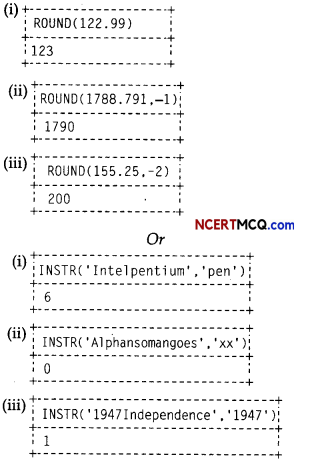
![]()
Question 9.
Even after trying so many times to get outputs using some MySQL functions, Rishika could not get the outputs as she was using wrong function names or improper parameter order. Help her in correcting the commands.
(i) SELECT REMAINDER( 11,2);
To get remainder of dividing 11 by 2.
Answer:
SELECT M0D( 11,2);
(ii) SELECT FINDP0S( ‘ circus ’, ‘ us ’);
To find the position of ‘us’ in ‘circus’.
Answer:
SELECT I NSTR( ‘ circus ’, ‘ us ’);
(iii) SELECT INSTR(‘os’,‘digitaltatoos’);
To find the position of ‘os’ in ‘digitaltatoos’.
Answer:
SELECT INSTR(“digitaltatoos”, “os”);
Question 10.
Rahul is confused about the order of parameters in following function calls. Help him to correcr the order of the parameters.
(i) SELECT MID(2.5, ‘mouseandkeyboard ’);
To extract 5 characters from position 2 of the string given.
Answer:
SELECT MIDC ‘mouseandkeyboard’ ,2,5);
(ii) SELECT POW(9.7);
To find 7<sup>9</sup>.
Answer:
SELECT POW(7,9);
(iii) SELECT M0D(2,19) ;
To find the remainder of dividing 19 by 2.
Answer:
SELECT M0D( 19,2);
Section – C
(Each question carries 4 Marks)
Question 11.
In a class of students of class XII IP Mr. John a teacher asked to identify the columns on which the records of following table can be grouped. They were also told to write some SQL queries as given below. Assuming you are also part of the class, answer the questions.
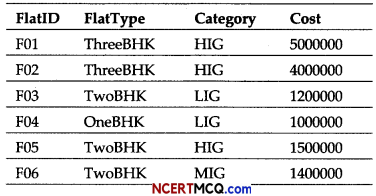
(i) Specify the columns on which the records can be grouped.
Answer:
FlatType, Category
(ii) Display the Category wise maximum costs.
Answer:
SELECT Category, MAX(Cost) FROM Building GROUP BY Category;
(iii) Display each FlatType and the number of flats of each type.
Answer:
SELECT FlatType, C0UNT(*) FROM Building GROUP BY FlatType;
(iv) Display the lowest flat cost.
Answer:
SELECT MIN(Cost) FROM Building;
![]()
Question 12.
The City hospital is maintaining the details of its patients like name, department, charges in a Patient table. They want to find out certain outputs for their performance analysis using some MySQL functions. Help them in their operations.
Table: Patient
| Pname | Dept | Charges |
| Roychowdhury | Paediatric | 1500 |
| Annapurna | Paediatric | 1000 |
| Naina | Ortho | 300 |
| Smriti | Ortho | 400 |
| Payal | Eye | 200 |
(i) SELECT SUM(Charges) FROM Patient WHERE Dept “Ortho”;
(ii) SELECT INSTR(Pname,”nn”) FROM. Patient WHERE Pname =”Annapurna”;
(iii) SELECT MAX(Charges) FROM Patient WHERE Dept=”Paediatric”;
(iv) SELECT MIN(Charges) FROM Patient WHERE Charges>=1000;
Or
The City hospital also wants to extract certain more parts from the patient names and find some more counts, help them in finding the outputs.
(i) SELECT COUNT(*) FROM Patient;
(ii) SELECT COUNT(DISTINCT Dept) FROM Patient;
(iii) SELECT SUBSTR(Pname, 5) FROM Patient WHERE Dept= “Paediatric”;
(iv) SELECT INSTR(Pname, “na”) FROM Patient;
Answer:
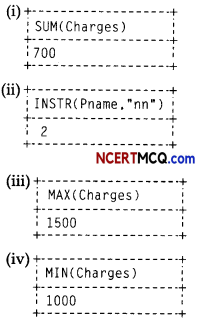
Or
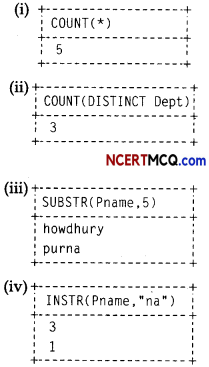
![]()
Question 13.
Calcutta International School, in Mumbai is starting up the network between its different wings. There are four buildings named as SENIOR, JUNIOR, ADMIN and HOSTEL as shown below.
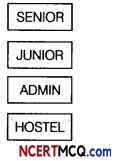
The distance between various buildings
| ADMIN TO SENIOR | 200 m |
| ADMIN TO JUNIOR | 150 m |
| ADMIN TO HOSTEL | 50 m |
| SENIOR TO JUNIOR | 250 m |
| SENIOR TO HOSTEL | 350 m |
| JUNIOR TO HOSTEL | 350 m |
Number of computers in each building
| SENIOR | 130 |
| JUNIOR | 80 |
| ADMIN | 160 |
| HOSTEL | 50 |
(i) Which topology will be best to use in each of the buildings?
Answer:
Star topology is best in terms of connectivity, attachment and detachment of nodes and error detection.
(ii) Name the building that is most suitable for placement of server.
Answer:
Since ADMIN building has maximum number of computers, it is the best place to house the server.
(iii) Where do they need to install a hub?
Answer:
As all the buildings have multiple computers, they need to be connected using hub.
(iv) Where do they need to install repeaters, if the buildings are connected?
Answer:
Since all the given connections have a distance more than 100 m, they all need a repeater.